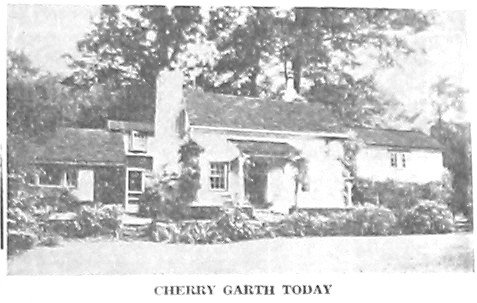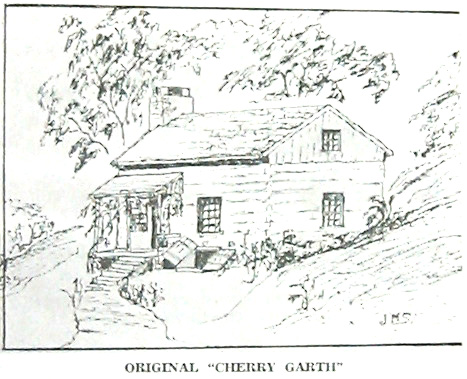In last week’s column we wrote of the many mills in Delaware County in the early days, the first one of which there is record being the grist mill established on Chester Creek in 1683 by a partnership of ten men, of whom William Penn was one. Among later mills of this type was the one operated in Radnor Township by William Davis in the early 1700’s. On the whole, however, Radnor Township had fewer mills and tanneries than most of its neighbors. This was due, according tot he historians who compiled the comprehensive volume on “Southeastern Pennsylvania”, to the fact that the creeks in the Township “were not large enough to produce a large quantity of power, and transportation difficulties discouraged 19th century industrialists.”
Among the many other types of mills that flourished generally throughout Delaware County were fulling mills. These were for the preparation of felt, for which there must have been extensive use in those early days since there are records of so many of these mills, particularly on “the famous Darby River”. One advertisement tells of a fulling mill in this vicinity where one could have “woolen cloth or druggets, milled, dyed, sheared and pressed; tammies and duroys scoured and pressed, and cloth or yarn dyed blue”.
Other types of mills which seemed to have been productive were those for the manufacture of such varied commodities as paper, leather, blades, snuff, powder, cotton yarn, flour, carpets, silk yarn and woolen goods.
Tanneries were not one of the very early industrial developments of Delaware County, although by the middle of the 18th Century there were a number of flourishing ones. Among these was a tan yard operated in Radnor in 1766 and 1767 by Adam Siter. There were apparently no forges or furnaces in Delaware County until about the same time as when tanneries became an important industry. This absence of early furnaces and forges was due in part to the lack of the iron ore which is so plentiful in some other parts of Pennsylvania. One of the earliest forges was one at Leiperville on Crum Creek while another was at the present Glen Mills.
Among the most interesting of these old time mills were those for the manufacture of paper. As early as 1729 the famous Willcox Paper Mills, then called the Ivy Mills, prepared paper for the United States Treasury Department, as well as for the governments of South America and for certain of the European countries.
During the 20th Century innumerable new industries have made their appearance in Delaware County. Few of these, however, are in Radnor Township. For the most part they center in the Chester district, the city of Chester itself being one of the outstanding ports and centers of industry along the Atlantic seaboard. Among the businesses with national and sometimes international fame are the Scott Paper Company, the Viscose Company, Congoleum, Nairn, Inc., Sun Shipbuilding Company, Sun Oil, Pure Oil, and Sinclair Refining Companies. Still others are Baldwin Locomotive Works, Westinghouse Electric, Aberfoyle Manufacturing Company for making cotton materials, General Steel Castings Corporation and Ford Motor Company.
From that first Delaware County grist mill established by William Penn and his partners in 1683 until now, when the County is a veritable center of all sorts of industries, is after all but a matter of a little more than 250 years. IN that comparatively short time our county has become a “vital workshop . . . of which America can be proud”, to quote once more from our history of “Southeastern Penn-eastern Pennsylvania”.
With the growth of machine-operated industries came problems of labor. Early in the 19th Century a movement for a shorter day’s work began in both England and America. In February, 1836, a meeting to oppose the long hour system was held by employees of cotton mills on Chester Creek. In May of the same year the group demanded higher wages or less hours of labor. These were among the first “labor meetings” in the country, since they presented the demands of the employees as a unit.
Soon meetings similar to the one held by the employees of the Chester County cotton-mills were held throughout all Delaware County. With the aid of the press, these groups compelled the State to pass a ten hour law in July, 1848, with the Delaware County representative in the Legislature strongly advocating the measure. Many persons contended, however, that the government could not determine by law how long a man should work. But by 1855 the law was really effective. It is interesting to note that this statute also prohibited the employment of children under thirteen years of age. A fine of fifty dollars was to be imposed for non-observance of this new statute.
Even as early as 1836 the employees of Crozer’s West Branch Mills called a strike to protest the discharge of one of its group. Later they held another strike to obtain higher wages. Though records do not show to what extent these strikers obtained their ends, they do indicate the birth of groups of employees working together for a common benefit. Now some hundred and more years later labor unions are so strong in Delaware County that the employees of every large industry are affiliated with the CIO, the AFL or a local company union.
(To be continued)


